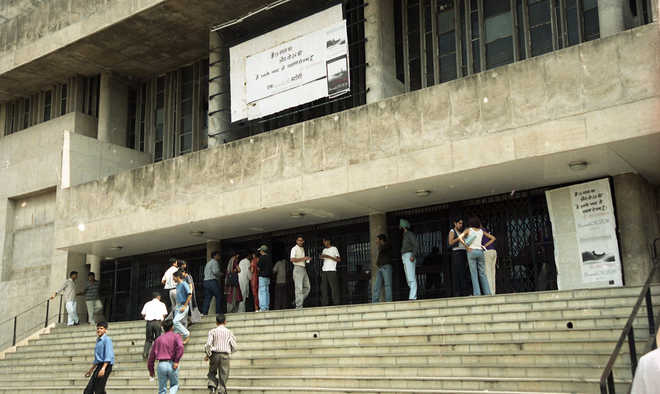Kaveesha Kohli
A fire burned down a part of Nirman Theatre in 2012. At the time, it was reported that the theatre would be reopened in three months. Fast forward seven years, the theatre never screened a movie again.
Today, the theatre in Sector 32 is almost deserted. The stairs leading up to the entrance lead to long collapsible gates that, barring a tiny entrance, are entirely shut. This opens into a large room, the lobby, which once hosted the theatre’s canteen — the menu still remains painted on walls. Now, the lobby has only dirty, black sofas, which are occupied by exactly one person — Mohal Lal, the theatre’s former manager.
“Now, I come here only for caretaking. Besides me, there are two or three other security guards,” says Mohan Lal.
According to Akshay Verma, who purchased the theatre in 2006, “The fire was the final straw. We were already bleeding dry.”
The theatre, which began functioning in the early 1980s, was previously owned by the Gulati family, the family also owns some famous apparel shops in Sector 17.
Like most single-screen theatres of the city, Nirman was inspired by Corbusier’s architectural style.
“The building of Nirman Cinema is a bold statement in reinforced concrete and is one of the finest examples of Brutalist Architecture in post-Independent India. With its unadorned facades in exposed concrete with steel shuttering pattern, the building echoes the architectural vocabulary of Le Corbusier,” according to Sarbjit Singh Bahga, principal architect at a Chandigarh-based urban design firm.
Changing times
According to Paro Yadav, a vendor near Nirman for the past 20 years, things began to change for the theatre in the early 2000s.
“The last movie which did well here was Amir Khan’s Mela (2000). Then Gadar (2001) was released and they didn’t screen it. People went to other theatres, almost never to return,” adds Yadav.
Bearing expenses
“Once the area was cleaned after fire, we realised that it didn’t make sense to operate it as it is,” says Verma.
Meanwhile, Verma has had to pay property tax, lease payment and maintenance costs which add up to Rs 7 lakh every year.
Over the years, Verma has had the option of either converting the theatre into a multiplex-cum-shopping complex or renovating the theatre to put in an improved seating system.
“However both these options are unviable. The former involves a huge conversion fee — running in crores,” he says.
Over the years, Verma also considered joint ventures with people who would invest in the theatre, but nothing materialised.
Verma had also previously approached the administration within a renovation plan, but the conversation had “fizzled out” and “there were no clear answers” from the administration.
Now, Verma is set to approach the administration again, with a plan to introduce multiple screens at Nirman, keeping the outside facade and seating capacity of 984 seats intact.
On the administration’s side not much has been done to support these old theatres. According to a source in the Architecture Department of the UT, a high level committee, which included UT’s Chief Architect and Chief Engineer, had been set up to look into the fate of single-screen cinemas. The committee, however, never met.
Unlock Exclusive Insights with The Tribune Premium
Take your experience further with Premium access.
Thought-provoking Opinions, Expert Analysis, In-depth Insights and other Member Only Benefits
Already a Member? Sign In Now










